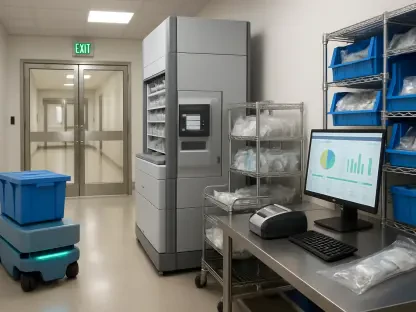The healthcare sector has long been regarded as a critical and complex facet of modern societies. However, its very complexity and essential nature make it a prime target for cyberattacks and vulnerable to natural disasters. Recent events, such as the ransomware attack on OneBlood amidst Hurricane Debby, have brought to light the vulnerabilities within healthcare supply chains, particularly those involving life-saving resources like blood. These incidents underscore the vital need for a more resilient and secure network to ensure the continuity of essential services.
Cyber Attacks on Healthcare Supply Chains
OneBlood Ransomware Attack
On July 29, OneBlood, a Florida-based nonprofit blood center, faced a severe ransomware attack. This cyber assault disrupted its operations significantly, forcing the organization to revert to manual processes for testing and labeling blood products. As a result, notable delays occurred, pushing hospitals to activate critical blood shortage protocols. This incident underscores the pivotal role cyber resilience plays in healthcare operations. It showed how a single cyber incident can ripple through the entire healthcare system, affecting patient care and safety.
Adding to the overall strain, the attack on OneBlood coincided with Hurricane Debby. This natural disaster further complicated matters, as potential donors focused on their safety, resulting in reduced blood donations. The convergence of these crises highlighted the compounded risks that can stem from simultaneous natural and cyber events. The combination brought the healthcare sector to a critical point where both digital and natural elements need to be considered when planning for disaster recovery and risk management. This dual threat scenario emphasizes the pressing need for integrated contingency planning.
Immediate and Broader Impacts on Patient Safety
The ramifications of the OneBlood attack extended beyond logistical challenges and directly impacted patient care. Hospitals that depend on a steady blood supply for transfusions faced critical hurdles. OneBlood’s recovery efforts included a mix of manual operations and support from other blood centers to meet immediate needs. However, the critical software systems required reverification, leading to a reduced operational capacity. This situation reflected the broader challenge within the healthcare sector, where technology plays an indispensable role in ensuring timely and effective patient care.
As OneBlood called for public blood donations, it became evident that the healthcare system’s interdependent nature demands a swift, coordinated response to such disruptions. This event serves as a stark reminder of the delicate balance required to maintain an adequate supply of life-saving resources. The interconnectedness of healthcare services means that a disruption in one area can have severe knock-on effects, stressing the critical need for robust, multi-layered emergency preparedness plans.
Response and Recovery Efforts
Public Appeal and Cross-Regional Support
In the wake of the attack, OneBlood issued a public appeal for blood donations. National blood industry partners stepped in to provide supplemental supplies, mitigating some of the shortages. This collaboration underscores the importance of cross-regional support in times of healthcare crises. Collaborative efforts not only helped stabilize the immediate situation but also highlighted the value of having a network of partners ready to offer support when critical needs arise.
The organization’s primary focus remained on restoring its critical software systems. An ongoing investigation aimed to discern whether patient data had been compromised. Notably, no specifics about ransom demands or payments were disclosed, reflecting the sensitive nature of negotiations in such scenarios. These investigative efforts are crucial for understanding the scope of the attack and preventing future incidents. Comprehensive cybersecurity measures and vigilant monitoring are essential to safeguard healthcare operations against such looming threats.
Operational Priorities and Investigation
The immediate priority for OneBlood was the restoration of its critical software systems and ensuring the integrity of its operations. Implementing manual processes for testing and labeling blood products was a short-term solution, emphasizing the need for robust contingency plans in the healthcare sector. These manual procedures, although challenging, ensured that the flow of blood supplies continued albeit at a reduced capacity.
An in-depth investigation aimed to determine the extent of the breach and whether patient data had been compromised. Such probes are essential to understand the scope of cyber threats and to develop more effective defense mechanisms in the future. This situation is a stark reminder of the evolving landscape of cyber threats and the importance of adaptability and preparedness. Healthcare organizations must prioritize robust cybersecurity frameworks to defend against increasingly sophisticated cyberattacks.
Patterns of Cyber Attacks on Healthcare
Other Recent Attacks
The attack on OneBlood is not an isolated incident. Similar attacks have recently targeted other blood centers, such as Octapharma Plasma and British provider Synnovis. Both of these attacks were linked to Russian-speaking ransomware gangs, indicating a pattern of targeting critical healthcare suppliers. This disturbing trend demonstrates the organized and strategic efforts of cybercriminals who are well aware of the vulnerabilities within the healthcare sector.
For instance, Octapharma Plasma witnessed an extensive shutdown of nearly 200 plasma donation centers due to an attack attributed to the BlackSuit gang. Similarly, Synnovis faced disruptions affecting blood supplies in the UK, claimed by the Qilin gang. These events highlight a disturbing trend of cybercriminals focusing on pivotal healthcare components. By targeting supply chains, cybercriminals aim to cause maximum disruption, knowing the essential nature of these services means organizations may be more likely to pay ransoms.
Expert Insights and Regulatory Concerns
Regulatory attorney Betsy Hodge emphasized the increasing impact of cyberattacks on healthcare organizations’ ability to provide safe care. The dependency on accessible and secure data underscores the interconnected nature of healthcare systems. The compounded risks from natural disasters, as seen with Hurricane Debby, illustrate how environmental factors can magnify the impact of cyberattacks. This convergence of threats requires a holistic approach to emergency preparedness, considering both digital and physical vulnerabilities.
This convergence of cyber and natural threats calls for a comprehensive approach to risk management, ensuring that healthcare providers are well-prepared to manage both types of crises simultaneously. The healthcare sector must adopt an integrated risk management approach that considers various threat vectors. Collaboration between cybersecurity experts, healthcare providers, and regulatory bodies is essential to develop and implement effective strategies for mitigating such multifaceted threats.
Strategic Responses and Industry Warnings
Industry-Wide Alert
In response to these escalating threats, the American Hospital Association (AHA) and Health Information Sharing and Analysis Center (H-ISAC) issued a joint warning. They urged the healthcare sector to bolster supply chain security and resilience. This alert serves as a wake-up call to address the vulnerabilities exposed by recent attacks. The urgency conveyed by AHA and H-ISAC emphasizes the need for immediate and comprehensive actions to fortify healthcare supply chains against cyber threats.
Call for Enhanced Risk Management
Emphasizing the need for enhanced risk management, the alert highlighted several recommendations for healthcare organizations. These included integrating mission-critical third-party suppliers into enterprise risk management plans, prioritizing risk management principles with partners and suppliers, and identifying alternative suppliers to ensure redundancy. Creating a more resilient healthcare ecosystem capable of withstanding cyber threats and natural disasters requires strategic planning and proactive measures.
These measures aim to create a more resilient healthcare ecosystem capable of withstanding cyber threats and natural disasters. Comprehensive risk management plans that involve all stakeholders, from suppliers to end-users, will be fundamental in building a robust defense against complex and evolving threats. The healthcare sector must invest in technologies, processes, and training to stay ahead of cybercriminals and ensure the safety and continuity of patient care.
Broader Context and Historical Perspective
Trend of Increasing Third-Party Supplier Attacks
The focus on third-party vendors reveals a broader trend where cybercriminals are increasingly targeting ancillary, yet critical, components of the healthcare system. Notable incidents like the February ransomware attack on Change Healthcare, which disrupted U.S. hospitals’ revenue cycles, illustrate how integral these suppliers are to the functioning of healthcare services. Attacking these third-party suppliers allows cybercriminals to cause widespread disruption without directly attacking the primary healthcare providers.
This increased focus on third-party suppliers has shone a light on the vulnerabilities within healthcare supply chains. Organizations must ensure that their partners also adhere to stringent cybersecurity standards. This interconnected vulnerability calls for a unified effort to secure all links in the supply chain. Joint efforts between healthcare providers and their suppliers are necessary to implement comprehensive security measures that protect the entire ecosystem.
Conclusions
The healthcare sector has always been seen as both critical and complex, making it an essential component of modern societies. This inherent complexity, along with its crucial nature, unfortunately makes it a prime target for cyberattacks and highly susceptible to natural disasters. A striking example can be seen in the recent ransomware attack on OneBlood, which occurred during Hurricane Debby. This incident has highlighted significant vulnerabilities within healthcare supply chains, especially those dealing with life-saving resources like blood.
These types of disruptive events cannot be dismissed; they emphasize the pressing need for a more robust and secure network capable of maintaining the continuity of essential services. Without a resilient infrastructure, the risk of catastrophic failures increases, affecting patient care and the overall system’s ability to function effectively. Reinforcing the security measures and disaster readiness protocols will not only protect critical resources but also ensure that the healthcare sector can weather various challenges, from cyber threats to natural calamities. Therefore, strengthening the healthcare network’s resilience and security is paramount to safeguarding public health and maintaining reliable access to essential services.









